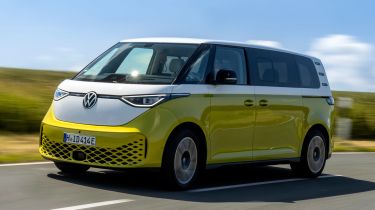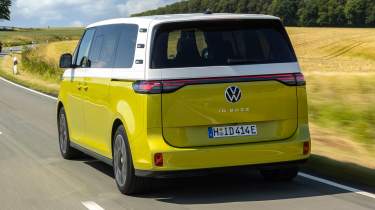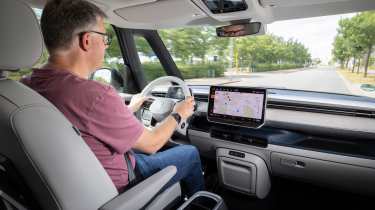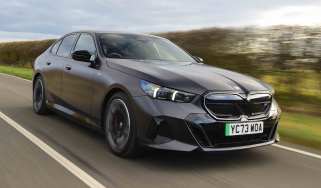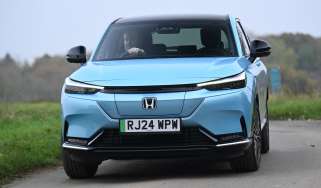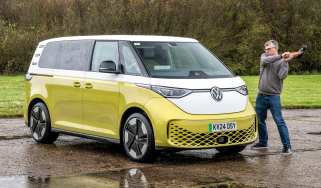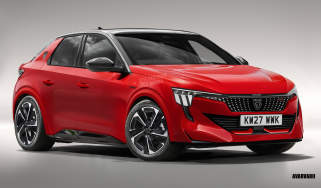New Volkswagen ID. Buzz LWB 2024 review: electric MPV finally gets seven seats
The all-electric Volkswagen ID.Buzz MPV grows in size and gains some useful improvements

Verdict
This is the car the Volkswagen ID. Buzz should always have been; more practicality, a host of small but useful improvements, and a little bit more range make the long-wheelbase model the obvious choice. And that’s before you factor in the tiny price premium over the regular car that absolutely seals the deal. Unless a LWB genuinely won’t fit where you park, there’s no reason to go for the car currently on sale, when the new one is significantly better in almost every way.
It’s rare that an addition to a model’s range renders the existing car pretty much pointless. But without jumping straight to the verdict, Volkswagen adding 250mm to the ID. Buzz’s length and slotting in a third row of seats for the first time – and asking just £510 for the pleasure – makes the long-wheelbase car about as logical a choice as you’ll find. And that’s before we mention the fact that it gets a tiny bit more range and a faster charging, on top of the extra metalwork and practicality.
The Buzz LWB comes in the same Life and Style trim levels as the regular model, but can be had as a no-cost option with five, six or seven seats. Five leaves way for an even bigger boot, but is pointless when more seats don't cost any more money.
More reviews
Car group tests
- Volkswagen ID. Buzz vs Lexus LM: which is the best fancy family car?
- Volkswagen ID. Buzz vs Tesla Model Y: 2023 twin test review
In-depth reviews
Long-term tests
Road tests
Picking between the six or seven-seat configurations will come down to whether the extra middle-row seat is more useful than two individual chairs with space to walk through in between. Both have their merits, but the seven seater will probably be more sensible for more people; the six seat layout does feel a bit more luxurious, mind, with nicer individual chairs in the middle row and somewhere to stretch out for those in the very back.
No matter what layout, the third row is spacious enough for adults to sit comfortably from a width and particularly legroom perspective, with the Buzz well capable of carrying seven adults in comfort – or kids thanks to the additional Iosfix points back there. There’s even space for a good-sized suitcase or three in the 306-litre boot. For context, that’s just shy of what you’ll find in a Vauxhall Corsa supermini.
Drop the rear-most seats and the luggage area jumps to 1,340 litres – 219 more than the shorter Buzz – and for full wardrobe-shifting spec, the middle row also folds for a Ford Transit-like 2,469 litres of space.
If it’s a wardrobe and chest of drawers, seats six and seven can be removed completely, along with the so-called multiflex board shelf in the boot. The seats are pretty heavy to lift out, but easy enough to slot back in. They do at least have a handle to make them a little easier to haul around.
On the road, there’s no significant change to the driving experience, which means a high driving position with great visibility thanks to the upright glass in every direction. There is a bit of a blind spot around the thick front pillar, however.
The growing exterior isn’t the only big change, with a new 282bhp motor landing in all Buzz models (including regular cars from August), replacing the existing 201bhp version, and mated to a larger 86kWh battery for the LWB. Meanwhile, standard cars get a small boost from 77 to 79kWh.
That means range jumps from a best of 258 miles to 291 miles on the entry-level Life SWB and 286 miles on the higher-spec Style. That translates to 283 miles and 277 miles respectively on the longer car. That bigger battery also has a faster maximum charge speed at 200kW versus 185kW, which means they take around the same time to charge – under half an hour from 10-80 per cent, according to VW.
The extra power does make the Buzz feel perkier, although maybe not as much as the figures suggest – the 0-62mph time drops from the current 10.2 seconds, to 7.6 on the regular wheelbase, or 7.9 seconds with the extra couple of hundred kilograms of the longer version. But it doesn’t feel like a major difference in what is still very much a big, tall vehicle with little interest in rapid cornering. And it still won't hit three figures for top speed, dropping one mile per hour short flat out. No bad thing, given how higher speeds have pretty awful consequences for the range.
Better all round, then, to throttle back and enjoy the space, comfort and the airy cabin, especially with the new option of a clever panoramic roof that swipes from open to closed at the press of a switch. Light steering, a commanding driving position, responsive acceleration and good brake feel (for an electric car), make the Buzz relaxing to drive, plus the good turning circle even on the new longer model means it’s easier to pick through town than might be expected for such a hefty car.
VW has also used the LWB’s arrival to do some enhancing of the Buzz as a whole. All cars now get a little sliding rear window – previously there was no access to fresh air from the back seat – along with a new 12.9-inch infotainment system that’s a welcome update of what isn’t the most user-friendly or glitch-free of systems. A powered tailgate and electrically-operated sliding door are also now standard across the range, while a head-up display is on the options list for the first time.
A couple of years after launch, the Buzz has gained what it probably should have had from the start. A seven-seater was a pretty basic requirement for what already looks like a traditional MPV, and the other changes – including bigger battery, more performance and better tech – all move the car on in small but significant ways, and for a ridiculously small price premium.
| Model: | Volkswagen ID. Buzz Style LWB 286PS 86kWh |
| Price: | £64,345 |
| Powertrain: | 86kWh battery, 1x electric motor |
| Power/torque: | 282bhp/560Nm |
| Transmission: | Single-speed automatic, rear-wheel drive |
| 0-62mph: | 7.6 seconds |
| Top speed: | 99mph |
| Range: | 277 miles |
| Max charging: | 200kW, 10-80% <30 minutes |
| Size (L/W/H): | 4,982/2,211/1,924mm |
| On sale: | Late 2024 |

